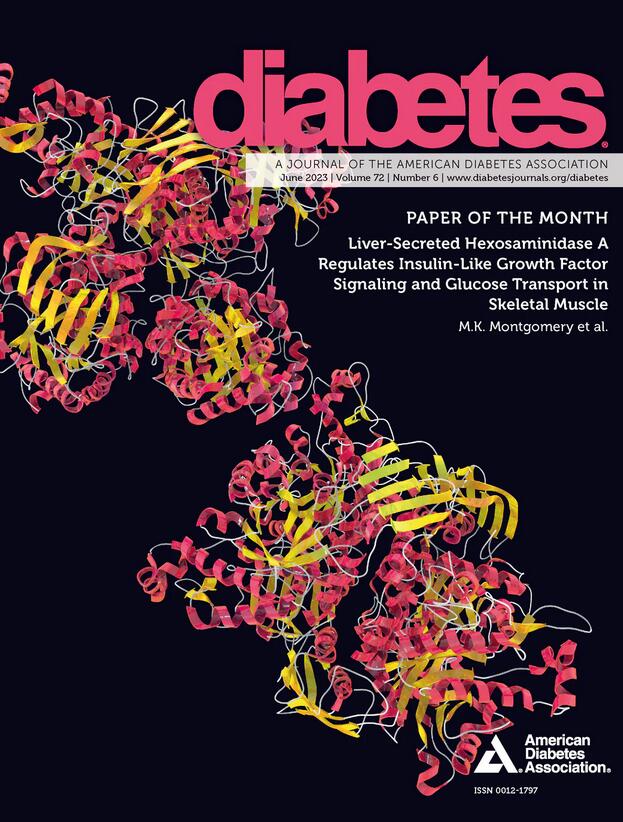综合蛋白质基因组学分析通过循环蛋白为1型糖尿病风险位点提供了新的解释
IF 6.2
1区 医学
Q1 ENDOCRINOLOGY & METABOLISM
引用次数: 0
摘要
循环蛋白可能是有前途的生物标志物或药物靶点。利用1型糖尿病(18,942例和501,638例对照欧洲血统)和循环蛋白丰度(10,708名欧洲血统个体)的全基因组关联研究,进行孟德尔随机化分析,评估1560种候选蛋白的循环丰度与1型糖尿病风险之间的关联,随后进行多重敏感性和共定位分析,水平多效性检查和重复。进行了大量组织和单细胞基因表达富集分析,以探索优先蛋白的候选组织和细胞类型。在验证孟德尔随机化假设和共定位证据后,我们发现遗传预测CTSH循环丰度(OR=1.17每增加一个标准差;95% ci:1.10-1.24), il27ra (or =1.13;95% ci:1.07-1.19), sirpg (or =1.37;95% CI:1.26-1.49)和PGM1 (OR=1.66;95% CI:1.40-1.96)与1型糖尿病风险相关。这些发现在其他队列中得到了一致的重复。CTSH、IL27RA和SIRPG在免疫系统相关组织中富集,PGM1在肌肉和肝脏组织中富集。免疫细胞中,CTSH在B细胞和髓细胞中富集,SIRPG在T细胞和自然杀伤细胞中富集。这些蛋白可以作为1型糖尿病的生物标志物或药物靶点。本文章由计算机程序翻译,如有差异,请以英文原文为准。
Integrative proteogenomic analyses provide novel interpretations of type 1 diabetes risk loci through circulating proteins
Circulating proteins may be promising biomarkers or drug targets. Leveraging genome-wide association studies of type 1 diabetes (18,942 cases and 501,638 controls of European ancestry) and circulating protein abundances (10,708 European ancestry individuals), Mendelian randomization analyses were conducted to assess the associations between circulating abundances of 1,560 candidate proteins and the risk of type 1 diabetes, followed by multiple sensitivity and colocalization analyses, horizontal pleiotropy examinations, and replications. Bulk tissue and single-cell gene expression enrichment analyses were performed to explore candidate tissues and cell types for prioritized proteins. After validating Mendelian randomization assumptions and colocalization evidence, we found that genetically predicted circulating abundances of CTSH (OR=1.17 per one standard deviation increase; 95% CI:1.10-1.24), IL27RA (OR=1.13; 95% CI:1.07-1.19), SIRPG (OR=1.37; 95% CI:1.26-1.49), and PGM1 (OR=1.66; 95% CI:1.40-1.96) were associated with the risk of type 1 diabetes. These findings were consistently replicated in other cohorts. CTSH, IL27RA, and SIRPG were strongly enriched in immune system-related tissues, while PGM1 was enriched in muscle and liver tissues. Amongst immune cells, CTSH was enriched in B cells and myeloid cells, while SIRPG was enriched in T cells and natural killer cells. These proteins may be explored as biomarkers or drug targets for type 1 diabetes.
求助全文
通过发布文献求助,成功后即可免费获取论文全文。
去求助
来源期刊

Diabetes
医学-内分泌学与代谢
CiteScore
12.50
自引率
2.60%
发文量
1968
审稿时长
1 months
期刊介绍:
Diabetes is a scientific journal that publishes original research exploring the physiological and pathophysiological aspects of diabetes mellitus. We encourage submissions of manuscripts pertaining to laboratory, animal, or human research, covering a wide range of topics. Our primary focus is on investigative reports investigating various aspects such as the development and progression of diabetes, along with its associated complications. We also welcome studies delving into normal and pathological pancreatic islet function and intermediary metabolism, as well as exploring the mechanisms of drug and hormone action from a pharmacological perspective. Additionally, we encourage submissions that delve into the biochemical and molecular aspects of both normal and abnormal biological processes.
However, it is important to note that we do not publish studies relating to diabetes education or the application of accepted therapeutic and diagnostic approaches to patients with diabetes mellitus. Our aim is to provide a platform for research that contributes to advancing our understanding of the underlying mechanisms and processes of diabetes.
 求助内容:
求助内容: 应助结果提醒方式:
应助结果提醒方式:


